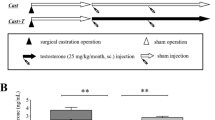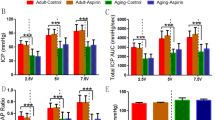Abstract
We hypothesize that downregulation of sex hormone receptors (androgen, estrogen and progesterone receptors) is involved in aging-related erectile dysfunction. To test this hypothesis, we investigated the expression of sex hormone receptors in penile crura of aging rats. A total of 40 rats were divided into four groups based on age (6, 12, 18 and 24 months), and the erectile function was analyzed by the measurement of intracavernous pressure. Gene and protein expressions of sex hormone receptors were analyzed by RT-PCR and immunostaining, respectively. The mean intracavernous pressures of 6-, 12-, 18- and 24-month-old rats were 110.1, 89.6, 73.5 and 42.7 cmH2O, respectively. Gene and protein expressions for androgen receptor, estrogen receptor-beta and progesterone receptor were present in similar levels in 6-, 12- and 18-month-old rat crura, but significantly lower or absent in 24-month-old crura. This is the first study to demonstrate that downregulation of sex hormone receptors in aging rat crura is associated with erectile dysfunction.
This is a preview of subscription content, access via your institution
Access options
Subscribe to this journal
Receive 8 print issues and online access
$259.00 per year
only $32.38 per issue
Buy this article
- Purchase on Springer Link
- Instant access to full article PDF
Prices may be subject to local taxes which are calculated during checkout





Similar content being viewed by others
References
Feldmann HA et al. Impotence and its medical and psychosocial correlates: results of the Massachusetts Male Aging Study. J Urol 1994; 151: 54–61.
Jonler M et al. The effect of age, ethnicity and geographical location on impotence and quality of life. Br J Urol 1995; 75: 651–655.
Penson DF et al. Androgen and pituitary control of penile nitric oxide synthase and erectile function in the rat. Biol Reprod 1996; 55: 567–574.
Guerra-Araiza C et al. Progesterone receptor isoforms expression in the prepuberal and adult male rat brain. Brain Res Bull 2001; 54: 13–17.
El-Sakka A et al. Effects of diabetes on nitric oxide synthase and growth factor genes and protein expression in an animal model. Int J Impot Res 1999; 11: 123–132.
Bakircioglu ME et al. Decreased trabecular smooth muscle and caveolin-1 expression in the penile tissue of aged rats. J Urol 2001; 166: 734–738.
Dahiya R et al. Differential gene expression of growth factors in young and old rat penile tissues is associated with erectile dysfunction. Int J Impot Res 1999; 11: 201–206.
Ferrini M et al. Aging-related expression of inducible nitric oxide synthase and markers of tissue damage in the rat penis. Biol Reprod 2001; 64: 974–982.
Garban H et al. Effect of aging on nitric oxide-mediated penile erection in rats. Am J Physiol 1995; 268: H467–H475.
Baskin LS et al. The effect of testosterone on androgen receptors and human penile growth. J Urol 1997; 158: 1113–1118.
Shabsigh R . The effect of testosterone on the cavernous tissue and erection. World J Urol 1997; 15: 21–26.
Traish AM et al. Effects of castration and androgen replacement on erectile function in a rabbit model. Endocrinology 1999; 140: 1861–1868.
Banerjee PP et al. Age-dependent and lobe-specific spontaneous hyperplasia in the brown Norway rat prostate. Biol Reprod 1998; 59: 1163–1170.
Aversa A et al. Androgen and penile erection: evidence for a direct relationship between free testosterone and cavernous vasodilation in men with erectile dysfunction. Clin Endocrinol 2000; 53: 517–522.
Kuiper GGJM et al. Comparison of the ligand binding specificity and transcript tissue distribution of estrogen receptors alpha and beta. Endocrinology 1997; 138: 867–870.
Zhou Y et al. Hepatic stellate cells contain the functional estrogen receptor beta but not the estrogen receptor alpha in male and female rats. Biochem Biophys Res Commun 2001; 286: 1059–1065.
Lindner V et al. Increased expression of estrogen receptor-beta mRNA in male blood vessels after vascular injury. Circ Res 1998; 83: 224–229.
Spyridopoulos I et al. Estrogen-receptor-mediated inhibition of human endothelial cell apoptosis. Estradiol as a survival factor. Circulation 1997; 95: 1505–1514.
Choi KC et al. Estradiol upregulates antiapoptotic Bcl-2 messenger ribonucleic acid and protein in tumorigenic ovarian surface epithelium cells. Endocrinology 2001; 142: 2351–2360.
Yamanaka M et al. Loss of anti-apoptotic genes in aging rat crura. J Urol 2002; 168: 2296–2300.
Labombarda F et al. Modulation of NADPH-diaphorase and glial fibrillary acidic protein by progesterone in astrocytes from normal and injured rat spinal cord. J Steroid Biochem Mol Biol 2000; 73: 159–169.
Acknowledgements
This research was supported by the National Institutes of Health Grants RO1DK055040 and RO1AG016870.
Author information
Authors and Affiliations
Corresponding author
Rights and permissions
About this article
Cite this article
Shirai, M., Yamanaka, M., Shiina, H. et al. Downregulation of androgen, estrogen and progesterone receptor genes and protein is involved in aging-related erectile dysfunction. Int J Impot Res 15, 391–396 (2003). https://doi.org/10.1038/sj.ijir.3901050
Received:
Revised:
Accepted:
Published:
Issue Date:
DOI: https://doi.org/10.1038/sj.ijir.3901050



